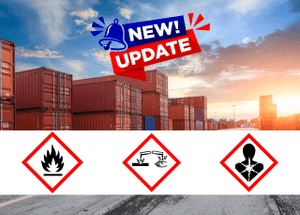Preventing Injuries in the Workplace

With April being Injury Prevention Month, it's a fitting time for businesses to revisit safety planning and training efforts. It's especially pertinent now, in the landscape of COVID-19, as many workplaces continue to update and adjust their policies with the health of employees, visitors or customers in mind.
Why Is Injury
Prevention Important?
With knowledge of hazards, and by creating and enforcing health and safety
rules, you’re working to safeguard employees from being among the 4,500+ who
die on the job, or the more than 4 million who suffer serious job-related
injuries and illnesses, reports the Department of Labor.
The prevalence of certain workplace hazards causing violations and harm to employees year over year – evidenced by OSHA’s top 10 violations list – goes to show that more can and should be done in today’s workplaces to improve worker safety. Looking back at previous years’ safety issues is another indicator of top issues at jobsites and what solutions are available to improve safety and reduce risk; for example workplace safety trends for 2021 showed that worker wellness, advances in PPE, and tech breakthroughs were standout trends.
Current OSHA
Regulations
An important way to improve workplace safety is to keep current on the most
recent OSHA regulations regarding illness, injury and death prevention. Assess
your workplace to determine the types of hazards that exist and require action
and visit OSHA’s website to provide insight on what to look for.
For example, common workplace hazards include:
- Safety, which includes conditions, substances and objects that pose a risk
- Chemical, which consists of vapors, liquids, gases, particulate matter and fumes
- Biological, which includes infectious materials, animals and other people
- Physical, which consists of extreme temperatures, radiation, loud noises and sun exposure
- Ergonomic, which includes musculoskeletal disorders
Then, determine your options for controlling and preventing hazards. What are other companies in your industry doing to mitigate unnecessary risk? Determine what measures make the most sense, fit your current budget and are actually effective. Check for redundancies and overlap. For instance, giving employees protection for their hearing may prevent hearing loss, but that protection could also make it so your employees can’t hear fire alarms, which creates a separate hazard.
Injury and
Illness Prevention Programs
From a big picture perspective, implementing an injury and illness prevention
program is an effective way to prevent injuries and reduce risk. An injury and
illness prevention program is a proactive process to help employers find and
fix workplace hazards before workers are hurt. Thirty-four states in the U.S.
and many countries around the world either require or encourage employers to
implement such programs.
According to OSHA, for workplaces who adopt these types of approaches, “Not only do these employers experience dramatic decreases in workplace injuries, but they often report a transformed workplace culture that can lead to higher productivity and quality, reduced turnover, reduced costs, and greater employee satisfaction.” Injury and illness prevention programs include common elements such as: management leadership, worker participation, hazard identification and assessment, hazard prevention and control, education and training, and program evaluation and improvement.
Adapting to the Ongoing COVID-19 Pandemic
Across all industries, workplace hygiene is a crucial element to an overall
effective and robust injury prevention program. Implementing and
practicing industrial hygiene and safety is an OSHA requirement and helps creates
a cleaner, safer working environment. In light of the ongoing COVID-19 pandemic, OSHA continues to issue guidance to protect workers from virus exposure; it's important for workplaces to be able to adapt their safety measures and protocol in line with the latest health and safety recommendations. Here, keep in mind that visual reminders – from COVID-19 safety signs to floor markers – can help to support your social distancing policies, hygiene protocols and PPE requirements.
Implementing Your
Health and Safety Rules for Employees
Develop your workplace safety rules and hazard control plan, which lays out how
to put your chosen control measures into action. Keep track of how controls are
coming along, and be sure you share your plan with your employees so they’re
informed. On a related note, keep in mind controls that apply to non-routine
operations, such as maintenance and equipment shutdowns and inclement weather
disasters. Be sure you perform all necessary follow-up to make sure every
aspect of your workplace safety plan is in place and fully operational. Throughout
your planning and implementation, take care that you adhere to the latest
compliance regulations, rules, codes, laws and best practices. That may include
specific
equipment safety labels, signs and tags to place
on your products or display in your facility.
What Are Top Ways
to Prevent Injuries?
Need a good, basic jumping-off point for your injury and illness prevention
plan? Here’s a quick checklist you can share with safety managers and
employees:
- Screen employees and applicants to ensure they are physically capable of carrying out their job duties.
- Continually educate employees and managers on the latest safety standards.
- Look into safety vulnerabilities.
- Provide safety equipment.
- Avoid shortcuts.
- Ensure enough employees are available to maintain workplace safety.
- Inspect and maintain company vehicles.
- Layout workspaces in a way that promotes safety and prevents slips, trips and the like.
When it comes to your workplace safety measures, consider the big picture perspective: these are key steps to take to avoid injuries, improve your workplace safety culture, and even impact your bottom line. Reach out to us here at Clarion Safety Systems for more workplace and equipment safety insight – including how we can help create custom labels, signs and tags in line with your injury and illness prevention program.
This blog was originally posted on 3/29/19 and has been updated with new information throughout.



